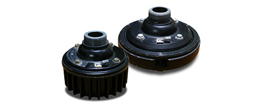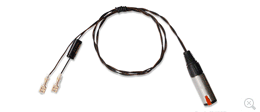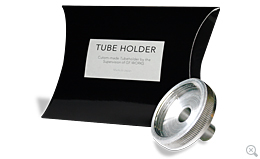2.Capacitors and Inductors
Compression drivers are designed to drive mid-high frequencies and do not work well with low frequencies. For example, the 1823M's frequency response is 400Hz-10kHz. Allowing low frequencies directly from the synth (anything below 400Hz) will damage the driver. To prevent damage, you will need to connect a combination of capacitors and inductors (high pass filter) between the amplifier and the driver to cut the unwanted low frequencies.
Capacitors and inductors can not eliminate frequencies right at the cutoff frequency, but decreases the level at a gradual slope. This slope is represented in dB/oct (decibel per octave), so when the cutoff frequency is at 400Hz, a slope of 6db/oct would decrease the power by 6dB in a span of one octave (in this case 200Hz), and a slope of 12dB/oct would decrease 12dB in a span of one octave (200Hz). The larger this ratio, the steeper the slope is. If you decide to run high power to the driver and would like to keep low frequencies up to the very limit, you will need something with a relatively high dB/oct.

Slope characteristics for various dB/oct
If one capacitor is connected in series to the speaker, it works as a 6dB/oct high pass filter and if an additional inductor is connected parallel to it, it becomes a 12dB/oct high pass filter. A more complex combination of capacitors and inductors could create 18dB/oct or 24dB/oct filters. Here, I would like to explain how to build a simple, low-cost 6dB/oct filter and a 12dB/oct filter than can run the driver at full-power.
To build a 6dB/oct High-Pass Filter:

This one is pretty simple, for you will only be adding one capacitor in series. The calculation to find out the capacitance of the capacitor suited for the compression driver is, C = 159000 (160000) / (R * FC):
- C = Capacitance
(unit: μF(microfarads))
- R = Impedance of the compression driver
(unit: ohms)
- Fc: Cutoff frequency (the lowest frequency the compression driver is capable of producing
(unit: Hz)
For example, in case of Electro Voice “1823M”, “159000 / (8Ohms * 400Hz) = 50μF” so a capacitor with 50μF capacitance should be used. However, because 6dB/oct is a fairly shallow slope, you might want to calculate Fc at 500 ~ 600Hz (40~30μF capacitance) to avoid any damage to the compression driver.
To build a 12dB/oct High-Pass Filter:

In this case, you will need a capacitor in series and an inductor in parallel to the compression driver. The calculation to find out the capacitance of the capacitor suited for the compression driver is, C = 113000 (112500) / (R * FC):
- C = Capacitance
(unit: μF(microfarads))
- R = Impedance of the compression driver
(unit: ohms)
- Fc: Cutoff frequency (the lowest frequency the compression driver is capable of producing)
(unit: Hz)
For example, in case of Electro Voice “1823M”, “113000 / (8Ohms * 400Hz) = 35μF” so a capacitor with 35μF capacitance should be used.
The calculation to find out the inductance of the inductor suited for the compression driver is, L = 225 * R / FC:
- L = Inductance
(unit: mH (milihenries))
- R = Impedance of the compression driver
(unit: ohms)
- Fc: Cutoff frequency (the lowest frequency the compression driver is capable of producing)
(unit: Hz)
For example, in case of Electro Voice “1823M”, “225 * 8Ohms / 400Hz = 4.5mH” so an inductor with 4.5mH inductance should be used.




